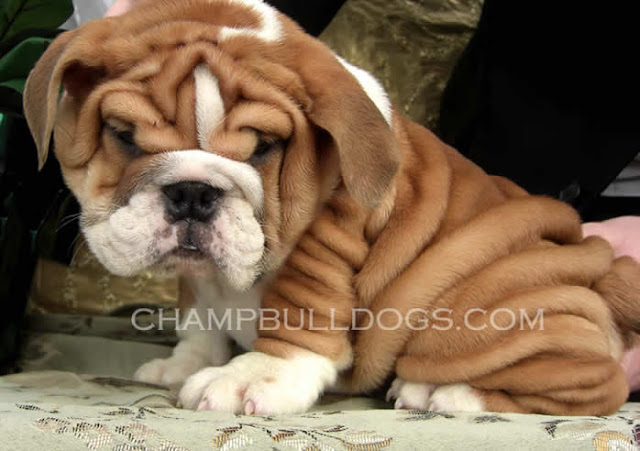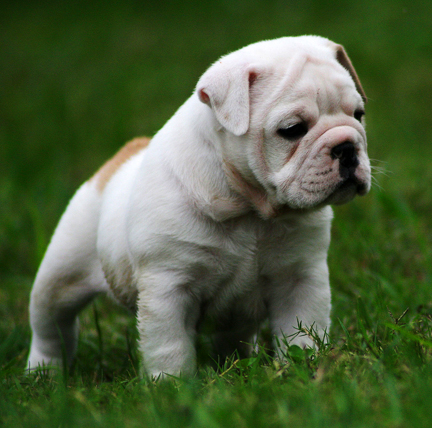The Bull Terrier is also known as: English Bull Terrier
Fast FactsGroup classification: Terrier Country of origin: England Date of origin: 19th century
Weight (M): 60 - 70 lb Height (M): 21 - 22" Life expectancy: 11 - 14 years
Weight (F): 50 - 60 lb Height (F): 21 - 22"

















General Description of the Bull Terrier
Strong and handsome, the Bull Terrier is a dog of muscular symmetry and sweet disposition. The head is long and deep, curving from nose to the top of the skull; when viewed from the front, the head should resemble an oval. Eyes are close and deep set, small and triangular. Ears are small, erect and close set; teeth meet in a scissors bite. The body is muscular and big boned, though never coarse. The tail is short and carried horizontally. Feet are round, compact and catlike. The Bull Terrier’s coat is short, glossy and harsh to the hand, and the skin should be tight throughout. Color is either solid white with our without markings on the head, or any color other than white (often brindle) with white markings on the head.
Bull Terrier Temperament
The Bull Terrier is a friendly and gentlemanly dog of inquisitive and imaginative temperament. It is always up for a game or a joke, and enjoys being around people. The Bull Terrier is a notoriously stubborn and assertive breed, and as such it may be a bit much to handle for a first time owner. Those with limited dog experience are encouraged to think twice before adopting this dog, since proper obedience training may be difficult. The Bull Terrier is aloof toward other dogs and, consistent with its terrier heritage, enjoys giving chase to small animals; occasionally, a poorly socialized or abused Bull Terrier may behave aggressively toward other dogs. Bull Terriers are usually pretty friendly toward strangers and other pets, especially when raised with them from a young age.
Caring for a Bull Terrier
Taking your Bull Terrier for a long walk or romp in the park every day will prevent hyperactive behavior and promote good health and long life in the dog. Take care that your dog is stimulated both physically and mentally, or you may come home to find your favorite pair of shoes in tatters. The Bull Terrier can adapt to outdoor living in temperate climates, though it prefers living inside. Coat care is easy, and entails little more than an occasional brushing to remove dead hairs. Some white Bull Terriers carry the Dalmatian’s deafness gene. Other health issues in the breed include hereditary neprhitis, cystic kidney disease, renal dysplasia, SAS, mitral stenosis, dilated cardiomyopathy and allergies.
Other:
Description: A replica of the Bull Terrier, the Miniature Bull Terrier shares the same breed standards except for the height. They are strongly built, symmetrical and active, with a keen, determined and intelligent expression. They have thick muscular bodies, despite their small stature. Miniature Bull Terriers are full of fire, having a courageous, even temperament. Mini Bulls are comical, lively, playful and mischievous dogs who may be small, but are not a lap dog. This breed has the distinctive mark of a muzzle without a stop. It has the typical Romanesque face. Mini Bull Terriers are active and tenacious. They can be fearless, but reserved when it comes to other dogs instigating a fight. Bull Terriers have been known to avoid fights when they are not the one picking it. They are not guard dogs, but they are scrappy fighters. They love to be with their family, and are a polite breed. The Miniature Bull Terrier has all of the spunk and tenacity of the larger Bull Terrier, just in a smaller package.
Other Names: English Bull Terrier, Miniature English Bull Terrier, Mini Bullies, Mini Bulls
Type: Terrier
Height: 10 - 14 inches.
Weight: 24 - 33 lbs.
Colors: White, white with another color or completely colored. They can be any dog color, including brindle, red, black, fawn or even tricolor. Blue and liver colors are undesirable in the show ring.
Coat: Short, dense, and flat, with a fine gloss.
Temperament: Miniature Bull Terriers are fearless and determined. They love to be companions, and thrive off of family. They are stubborn, courageous, playful and energetic. Mini Bullies are clownish, humorous and fun loving. They can be protective and willful, and do not obey orders consistently. They are difficult to train, and males usually do not get along with other males, although any other combination is fine. They love to play in family rough-housing and enjoy the company of their owners, and should not be left alone for hours.
With Children: Yes, generally good with children, but children should be warned not to tease them.
With Pets: Accepts most other pets, but needs to be socialized to cats. Males are aggressive with other males, but this breed will get along if the combination is male/female or female/female, as long as it is not male/male.
Special Skills: Family pet.
Watch-dog: Very High. Miniature Bull Terriers are very alert and protective.
Guard-dog: Medium. Although protective and sometimes possessive, they are not the biggest defensive dog.
Care and Exercise: Grooming is easy, minimal grooming is necessary for Miniature Bull Terriers. Brush with a firm bristle brush, bathe or dry shampoo when necessary. Bull Terriers need plenty of exercise, and should be kept on a leash.
Training: Training should begin early as they require firm and precise, but not overbearing handling.
Learning Rate: Low. Obedience - Low. Problem Solving - Low. This breed is mostly brawn.
Activity: High.
Special Needs: Attention, socialization, supervision around water and training.
Living Environment: Apartment living is fine as long as sufficient exercise is given to the Miniature Bull Terrier. Owners must desire an aggressive, active breed.
Health Issues: Zinc deficiency and deafness.
Life Span: 12 -13 years.
Litter Size: 1 - 9 puppies. Average is 5 puppies.
Country of Origin: Great Britain
History: The Miniature Bull Terrier is a direct descendant from the Bull Terrier and they share the same history. Bull Terriers were crossed with the old English Bulldog and English White Terrier (now extinct) in the early 19th century. James Hinks, from Birmingham in Great Britain, originally developed the breed between the 1830s and the 1860s. They are also most certainly mixed with Dalmatian, and are thought to have converged with the Spanish Pointer, Greyhounds and Whippets. White being Hinks' favorite color for the breed, the dogs were originally all white. The characteristics chosen from this mixing of the breeds was the egg shape of the head, the white color, and the small triangular eyes. Along with these preferred attributes came frequent deafness, heart disease and skin problems. At this time they were a lighter more agile dog who was used to bait bulls, dog fighting and to tackle vermin. Color was only added later on in the 1900s when crosses were made with the Staffordshire Bull Terrier. Added as an AKC variety of Bull Terrier, the coloreds were not originally well-received, but soon found their place. The white Bullies were nicknamed the "white Cavalier" because of their ability to discern pit fighting from confrontations outside of work. Some Bull Terriers were known to avoid a fight when they weren't in the pit, and were bred for the ability of not provoking a fight. Bull Terriers were prized for their courage, agility and tenacity. They were rated as the third most suitable breed in wartime achievements by Colonel James Y. Baldwin, Commander of the War Dogs Training Establishment. Originally, the ears had to be cropped, but since 1895 when cropping was outlawed in Britain the breed has since been fixed to have naturally cropped ears. At one time the smallest white bull terriers were called Coverwood Terriers. Sometime during the 1900s the Miniature Bull Terrier was bred from the smallest of Bull Terriers. At first, the distinction was set on the weight of the breed, this sometimes being no different between the two. This caused a number of Mini Bulls to be bred down so small they looked like Chihuahuas. Because of this, in the 1970s, the breeds' distinctions were set at height, making a Mini Bull to be under fourteen inches, and normally are no less than ten inches. Sometimes a defender and sometimes a clown, this uniquely shaped breed has since become a popular sight among Americans.






























































